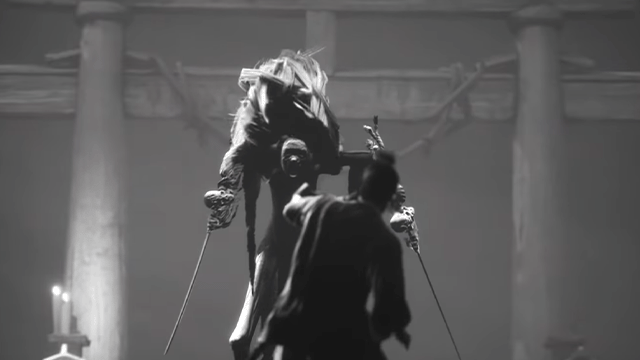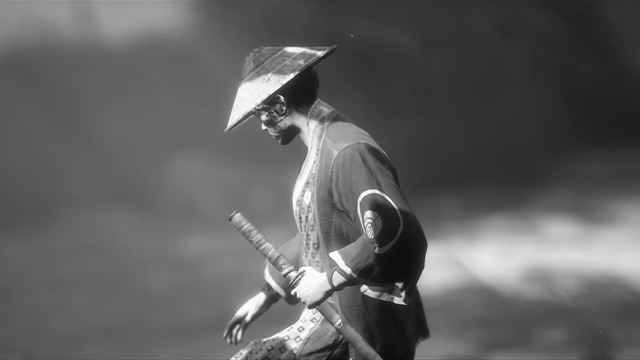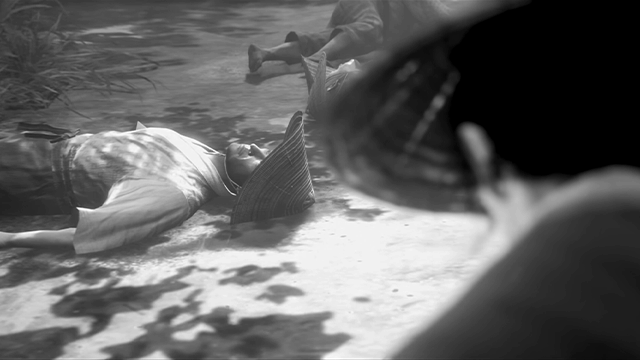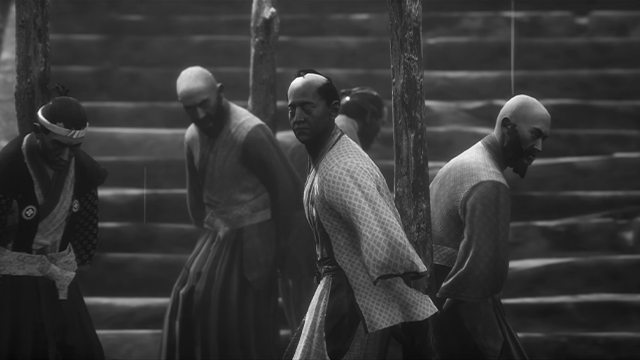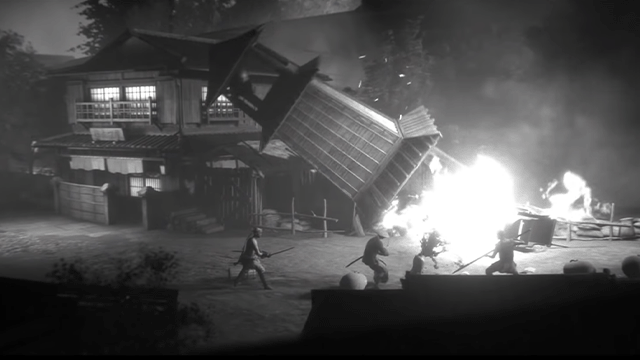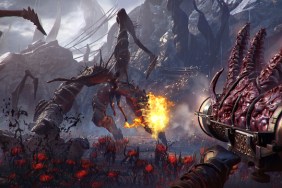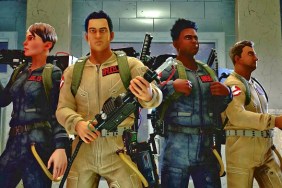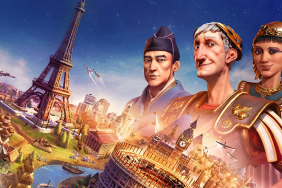Trek to Yomi takes us back to feudal Japan… again. Two of the best games of recent years, Sekiro and Ghost of Tsushima, shared this setting, and those are lofty heights for which to aspire. My big question heading into the game was if it could distinguish itself from its peers and shine a unique light with its tale of a lone samurai.
Heart of a Samurai
In Trek to Yomi, you play as a young samurai named Hiroki who is studying under the tutelage of Sanjuro, the feudal lord of an Edo period Japanese village. Things quickly go awry as a large contingent of bandits raids the town, and Sanjuro leaves Hiroki behind to protect his people. Hiroki disobeys his orders to hide and fights against bandits as he attempts to assist his master.
Thanks to Sanjuro’s training, he can brave the unorganized brigands, but their leader, Kagerou, quickly disarms him. However, Sanjuro arrives in time to prevent Hiroki’s death. Kagerou and Sanjuro face off against each other, and it appears that they mortally wound each other. Sanjuro asks Hiroki to help his daughter Aoki protect the village in his stead in his dying breath.
After a quick timeskip, we find that Hiroki has kept his word, and the village has healed from the bandit attack years before. However, after spending only a few minutes with the older Hiroki and Aoki, a man arrives from a neighboring village and reports that they’re under attack by a large army of bandits. Hiroki takes a contingent of samurai with him to assist his neighbors, but things aren’t as simple as they seem.
Unfortunately, the real-world story isn’t given much time to develop. Instead, we spend a good chunk of the game on our titular trek to (and through) Yomi, which slams the brakes on anything that’s actually happening.
A Fistful of Kurosawa
Akira Kurosawa’s work has been recreated, made homage to, or just plain ripped off time and time again. However, just with Yojimbo, we can see that excellent source material doesn’t necessarily make for a great adaptation. Sure, we got the seminal spaghetti western, A Fistful of Dollars, but it also inspired the painfully mediocre Last Man Standing. Trek to Yomi fits somewhere between these two extremes. It doesn’t come close to capturing the enduring greatness of Kurosawa’s productions, but it doesn’t totally fail either.
The story is the weakest link for Trek to Yomi and is the most significant factor in separating it from Kurosawa’s works. Ponder Sanjuro, for instance. The interplay between the worldly Sanjuro and the nine greenhorn samurai injects a constant mix of humor and tension into the narrative. Sanjuro finds himself facing Superintendent Kikui’s overwhelming army and his supposed allies’ incompetence, which keeps viewers guessing where the next conflict will spring from.
There’s none of this sort of push-and-pull in Trek to Yomi since the majority of the game is spent fighting monsters and spirits in the underworld while Hiroki beats himself up over nothing. I understand the Bushido concept of “duty” ran a lot deeper than the Western meaning of the word. Still, his whole journey through the underworld had me questioning if I’d missed something. The big takeaway (and the three paths available through the game) is that Hiroki must choose between love, duty, or revenge because those ideals are somehow incompatible with each other. However, there’s nothing in the game to show that’s the case.
The big bad of the game, the ronin (at least I assume he’s a ronin since he’s much more skilled than his goons) Kagerou, is just generically evil. He has no backstory other than he’s a bandit, and he’s mean. That’s it. Returning to Sanjuro, one of the main villains, Hanbei, is the opposite side of Sanjuro’s coin. In the end, we see Sanjuro try to have mercy on Hanbei when he demands a dual because of how similar the two are but is forced to kill him anyway. We learn from this that no matter how similar Sanjuro and Hanbei may seem on the surface, Sanjuro’s grace sets them entirely apart. Kagerou and Hiroki don’t have a dynamic relationship like that, and the game suffers for it.
Beauty at the expense of gameplay
The cinematography in the game does an admirable job of mimicking Kurosawa. The grayscale is lovely, and the filters give the gritty and soft feel of old film. Lots of exaggerated effects are used to punctuate scenes. Large, undying flames are blown by huge gusts of wind, creating a beautiful interplay of light and shadow. Mists give a dreamlike quality to scenes, and a subtle haziness clearly defines Yomi from the real world. There’s plenty of eye candy here, and no one can say this isn’t a pretty game.
Despite these fantastic shots, the visuals tend to fall apart during gameplay. It suffers from the same issue that nearly every other sidescroller in the HD age does in that your character is too damn small to see. This is incredibly irritating in every game that follows this trend, but it becomes something more when you’re playing in grayscale.
The camera constantly zooms in and out, and there’s no established viewpoint during exploration. It also often shifts to fixed angles, so you’ll frequently transition and lose sight of Hiroki. During combat, the camera at least sticks to a traditional side-scrolling viewpoint most of the time, but again, there’s no fixed zoom. So, sometimes you can see your foes clear as day, and other times it’s like watching ants fight. Unfortunately, players have no control over the camera at any point, so those who are vision-impaired are out of luck if they want to play this game.
The music is outstanding. Many of Kurosawa’s films were scored according to their time period by illustrious composers like Fumio Hayasaka and Masaru Sato. Trek to Yomi’s score emulates this and predominately features Edo period instruments played by an authentic gagaku ensemble.
However, Trek to Yomi missing a lot of the human element that made films like Yojimbo so endearing to audiences. Hideki is no Toshiro Mifune, and he really has no defining personality traits other than adherence to duty. If he’d had a chance to develop past a superficial relationship with any of the characters in the game, then things might have been different. As it is, Trek to Yomi is a Kurosawa film with all the close-ups and choreography removed, leaving only the pretty wide-angle shots to sate viewers.
Stunning combat
Combat in Trek to Yomi is complex and visceral on paper, but in practice, it’s not. Hideki’s primary armament is a katana, and he has a weak and strong attack. Players can attack or defend three positions, high, medium, and low. As the game continues, you unlock combos that increase your offensive capabilities.
However, there’s no reason to use anything other than the two or three combos that inflict the stun effect on enemies. Stunning enemies refills your health and allows you to use a deathblow that instantly kills them. Almost every regular enemy can be stunned, and you only have to hit them with the last attack in a combo to execute it. This makes the entire combat system irrelevant outside of bosses. You can guard and counter as well, but you’ll only face a max of two enemies at a time since combat happens on a 2D plane, so things never really get tough enough to worry about defense.
There are also some ranged weapons, a bow, bow shuriken, and a Tanegashima. The ranged weapons are fairly overpowered and can get you out of the rare sticky situation you find yourself in.
Trek to Yomi Review: The final verdict
Trek to Yomi is a fun enough five hours for the money. I wasn’t expecting Ghost of Tsushima for $19.99, so I wasn’t disappointed with what I got. However, I’m a big weeb, love Kurosawa, and think katanas are cool. I’m not sure if those unfamiliar with the design principle behind the game will understand where it’s coming from. It might serve as a gateway drug to Japanese cinema for some, but I think many people will just be wondering why it’s in black and white instead of color. Overall, it’s like a samurai with a dull sword: flashy, but lacking the razor edge needed to cut its way through the shadow of its contemporaries.
We reviewed Trek to Yomi on PC via code provided by the publisher. We completed the main game on normal and played an additional couple of hours on hard.
-
Some truly beautiful scenes that capture Kurosawa's work.
-
The experience is worth the asking price.
-
Combat is made shallow by the stun mechanic.
-
Narrative is simplistic and trite.
-
Sometimes hard to see your character on-screen.
